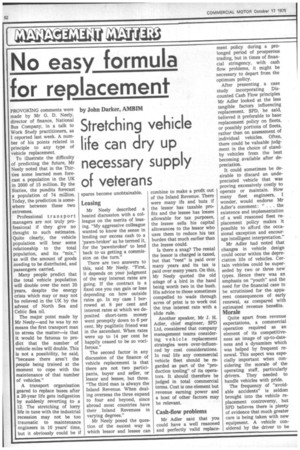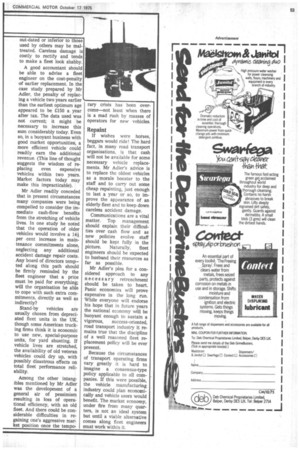No easy formula for replacement
Page 54

Page 55

If you've noticed an error in this article please click here to report it so we can fix it.
by John Darker, AMBIM
Stretching vehicle life can dry up necessary supply of veterans
spares become unobtainable. PROVOKING comments were made by Mr G. D. Neely, director of finance, National Bus Company, in a talk to Work Study practitioners, as I reported last week. A number of his points related in principle to any type of vehicle replacement.
To illustrate the difficulty of predicting the future, Mr Neely noted that in the Thirties some learned men forecast a population in the UK in 2000 of 15 million. By the Sixties, the pundits forecast a population of 74 million. Today, the prediction is somewhere between these two extremes.
Professional transport managers are not truly professional if they give no thought to such estimates. Quite clearly, the vehicle population will bear some relationship to the total population, and its "mix," as will the amount of goods needing to be distributed, and passengers carried.
Many people predict that the total vehicle population will double over the next 20 years, despite the energy crisis which may or may not be relieved in the UK by the advent of North Sea and Celtic Sea oil.
The major point made by Mr Neely—and he was by no means the first transport man to stress the matter—is that it would be fatuous to predict that the number of vehicle miles will double. This is not a possibility, he said, "because there aren't the people being trained at the moment to cope with the maintenance of that number of vehicles."
A transport organisation geared to replace buses after a 20-year life gets indigestion by suddenly reverting to a 12. The stretching of lorry life in tune with the industrial recession may not be too traumatic to maintenance engineers in 10 years' time, but it obviously could be if
Leasing
Mr Neely described a heated discussion with a colleague on the merits of leasing. "My aggressive colleague wanted to know the sense in lending our excess cash to a 'pawn-broker' as he termed it, for the 'pawnbroker' to lend back to us getting a commission on the turn."
There are two answers to this, said Mr Neely. "First, it depends on your judgment of the way interest rates are going. If the contract is a fixed one you can gain or lose depending on how outside rates go. In my case I borrowed at 8 per cent and interest rates at which we deposited short-term money went promptly down to 6 per cent. My pugilistic friend was in the ascendant. When rates were up to 14 per cent he happily ceased to be so vociferous."
The second factor in any discussion of the finance of vehicle replacement is that there are not two participants, buyer and seller, or lessor and lessee, but three. "The third man is always the Inland Revenue. When dealing overseas the three expand to four and beyond, since abroad most countries have their . Inland Revenues in varying degrees."
Mr Neely posed the question of the easiest way in which lessor and lessee can combine to make a profit out of the Inland Revenue. There were many ifs and buts if the lessor has taxable profits and the lessee has losses allowable for tax purposes, the lessee sells his capital allowances to the lessor who uses them to reduce his tax burden that much earlier than the lessee could.
Is there a snag? The rental the lessor is charged is taxed, but that "rent" is paid over many years and its tax is paid over many years. On this, Mr Neely quoted the old adage of a bird in the hand being worth two in the bush. His advice to those sometimes compelled to wade through acres of print is to work out the true interest rate with a slide rule.
Another speaker, Mr J. H. Adler, chief engineer, SPD Ltd, considered that company management teams considering vehicle replacement strategies were over-influenced by cost considerations. In real life any commercial vehicle fleet should be regarded as part of the "production tooling" of its operators. It should therefore be judged in total commercial terms. Cost is one element but revenue earning power and a host of other factors may be relevant.
Cash-flow problems
Mr Adler saio that you could have a well reasoned and perfectly valid replace ment policy during a prolonged period of prosperous trading, but in times of financial stringency, with cash flow problems, it might be necessary to depart from the optimum policy.
After presenting a case study incorporating Discounted Cash Flow principles Mr Adler looked at the less tangible factors influencing replacement. SPD, he said, believed it preferable to base replacement policy on fleets, or possibly portions of fleets, rather than on assessment of individual vehicles. Often, there could be valuable judgment in the choice of standby vehicles from the best becoming available after depreciation.
It could sometimes be desirable to discard an undepreciated vehicle that was proving excessively costly to operate or maintain. How many fleet engineers, I wonder, would endorse Mr Adler's comment : " . . the existence and implementation of a well reasoned fleet replacement policy makes it possible to afford the occasional exception and encourage intelligent interpretation."
Mr Adler had noted that changes in vehicle design could occur within the depreciation life of vehicles. Certain vehicles could be superseded by two or three new types. Hence there was an emphasis on "youth" and the need for the financial case to be scrutinised for the apparent consequences of early renewal, as compared with estimated revenue benefits.
Morale
Quite apart from revenue expectations, a commercial operation required as an element of its competitiveness an image of up-to-dateness and a dynamism which was helped by frequent renewal. This aspect was especially important when considering the morale of the operating staff, particularly drivers. They needed to handle vehicles with pride.
The frequency of "avoidable accidents" is seldom brought into the vehicle replacement controversy, but SPD believes there is plenty of evidence that much greater care is being taken with new equipment. A vehicle considered by the driver to be out-dated or inferior to those used by others may be mal treated. Careless damage is costly to rectify and tends to make a fleet look shabby. A good accountant should be able to advise a fleet engineer on the cost-penalty of earlier replacement. In the case study prepared by Mr Adler, the penalty of replac ing a vehicle two years earlier 1/4 than the earliest optimum age appeared to be £150 a year after tax. The data used was not current; it might be necessary to increase this sum considerably today. Even so, in a buoyant business with good market opportunities, a more efficient vehicle could readily earn the additional revenue. (This line of thought suggests the wisdom of re placing even expensive vehicles within two years. Market factors today may make this impracticable).
Mr Adler readily conceded that in present circumstances many companies were being compelled to consider the immediate cash-flow benefits from the stretching of vehicle lives. In one study he noted that the operation of older vehicles would involve a 144. per cent increase in maintenance commitments alone, neglecting any additional accident damage repair costs. Any board of directors tempted along this path should be firmly reminded by the fleet engineer that a price must be paid for everything; will the organisation be able to cope with such extra commitments, directly as well as indirectly?
Stand-by vehicles are usually chosen from depreciated fleet units in the UK, though some American trucking firms think it is economic to use new, special-purpose units, for yard shunting. If vehicle lives are stretched, the availability of old veteran vehicles could dry up, with possibly disastrous effects on total fleet performance Among the other intangibles mentioned by Mr Adler was the development of a general air of pessimism resulting in loss of operational efficiency, with an old fleet. And there could be considerable difficulties in regaining one's aggressive market position once the tempo rary crisis has been overcome—not least when there is a mad rush by masses of operators for new vehicles.
Repaint
If wishes were horses, beggars would ride! The hard fact, in many road transport organisations, is that cash will not be available for some necessary vehicle replacements. Mr Adler's advice is to replace the oldest vehicles as a morale booster to the staff and to carry out some cheap repainting, just enough to last a year or so, to improve the appearance of an elderly fleet and to keep down careless accident damage.
Communications are a vital matter. Top management should explain their difficulties over cash flow and as new policies evolve staff should be kept fully in the picture. Naturally, fleet engineers should be expected to husband their resources as far as possible.
Mr Adler's plea for a considered approach to any necessary retrenchment should be taken to heart. Panic economies will prove expensive in the long run. While everyone will endorse his hope that in future years the national economy will be buoyant enough to sustain a vigorous, success-oriented, road transport industry it remains true that the discipline of a well reasoned fleet replacement policy will be ever present.
Because the circumstances of transport operating firms vary greatly it is hard to imagine a consensus-type policy applicable to all companies. If this were possible, the vehicle manufacturing industry could plan economically and vehicle users would benefit. The market economy, under fire from many quarters, is not an ideal system but until a viable alternative comes along fleet engineers must work within it.
































































































